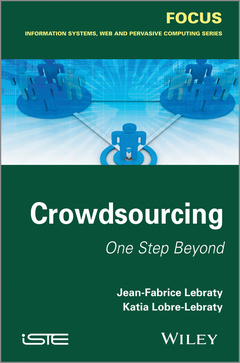Crowdsourcing One Step Beyond
Auteurs : Lebraty Jean-Fabrice, Lobre-Lebraty Katia

Crowdsourcing is a relatively recent phenomenon that only appeared in 2006, but it continues to grow and diversify (crowdfunding, crowdcontrol, etc.). This book aims to review this concept and show how it leads to the creation of value and new business opportunities.
Chapter 1 is based on four examples: the online-banking sector, an informative television channel, the postal sector and the higher education sector. It shows that in the current context, for a company facing challenges, the crowd remains an untapped resource. The next chapter presents crowdsourcing as a new form of externalization and offers definitions of crowdsourcing. In Chapter 3, the authors attempt to explain how a company can create value by means of a crowdsourcing operation. To do this, authors use a model linking types of value, types of crowd, and the means by which these crowds are accessed.
Chapter 4 examines in detail various forms that crowdsourcing may take, by presenting and discussing ten types of crowdsourcing operation. In Chapter 5, the authors imagine and explore the ways in which the dark side of crowdsourcing might be manifested and Chapter 6 offers some insight into the future of crowdsourcing.
Contents
1. A Turbulent and Paradoxical Environment.
2. Crowdsourcing: A New Form of Externalization.
3. Crowdsourcing and Value Creation.
4. Forms of Crowdsourcing.
5. The Dangers of Crowdsourcing.
6. The Future of Crowdsourcing.
About the Authors
Jean-Fabrice Lebraty is Professor of management sciences at IAE (Business School) at Jean Moulin ? Lyon 3 University in France and a member of the research laboratory Magellan EA3713. He specializes in the management of information and communication systems and his research notably concerns decision-making and the links between crowd and information technology.
Katia Lobre-Lebraty is Associate Professor of management sciences at IAE (Business School) at Jean Moulin ? Lyon 3 University in France and a member of the research laboratory Magellan EA3713. She specializes in management control and strategic management and her research concerns both the modes of governance of organizations and Open Data
INTRODUCTION ix
I.1. A typology of management situations x
I.2. Crowdsourcing: a multifaceted concept xii
ACKNOWLEDGMENTS xv
CHAPTER 1. A TURBULENT AND PARADOXICAL ENVIRONMENT 1
1.1. Economic financialization and its challenges 1
1.2. The mass diffusion of the Internet and its consequences 3
1.3. The paradoxical coexistence of scarcity and abundance around data 4
1.4. Unique simultaneity of crisis and immobilism 8
1.4.1. The online banking sector 9
1.4.2. The postal sector 10
1.4.3. The television sector 11
1.4.4. The training sector: French universities 12
1.4.5. The conclusion to be drawn from these cases: the crowd remains an underexploited resource 13
CHAPTER 2. CROWDSOURCING: A NEW FORM OF EXTERNALIZATION 15
2.1. The concept of externalization 17
2.2. The idea of relationships 18
2.3. The concept of a crowd 19
2.3.1. The connected crowd 21
2.3.2. Understanding the crowd 23
2.3.3. Crowds and experts 26
CHAPTER 3. CROWDSOURCING AND VALUE CREATION 29
3.1 Creation of value 30
3.2. What type of value? 34
3.3 What type of crowd? 35
3.4 Towards an adapted business model 40
CHAPTER 4. FORMS OF CROWDSOURCING 47
4.1. Crowdjobbing 49
4.1.1. What is it? 50
4.1.2. Why it works 51
4.1.3. Limitations 52
4.1.4. The future 53
4.2. Crowdwisdom 55
4.2.1. What is it? 56
4.2.2. Why it works 56
4.2.3. Limitations 57
4.2.4. The future 57
4.3. Crowdfunding 58
4.3.1. What is it? 58
4.3.2. An illustrative example 59
4.3.3. Why it works 61
4.3.4. Limitations 63
4.3.5. The future 64
4.4. Crowdsourcing and forecasting 65
4.4.1.What is it? 65
4.4.2. An illustrative example 66
4.4.3. Why it works 68
4.4.4. Limitations 68
4.4.5. The future 68
4.5. Crowdsourcing and innovation 69
4.5.1. What is it? 70
4.5.2. Why it works 72
4.5.3. Limitations 73
4.5.4. The future 75
4.6. Crowdsourcing and authenticity (C&A) 75
4.6.1. What is it? 76
4.6.2. Why it works 77
4.6.3. Limitations 78
4.6.4. The future 79
4.7. Crowdauditing 80
4.7.1. What is it? 81
4.7.2. Why it works 82
4.7.3. Limitations 83
4.7.4. The future 84
4.8. Crowdcontrol 85
4.8.1. What is it? 85
4.8.2. Why it works 86
4.8.3. Limitations 86
4.8.4. The future 87
4.9. Crowdcuration 88
4.9.1. What is it? 88
4.9.2. An illustrative example 89
4.9.3. Why it works 90
4.9.4. Limitations 91
4.9.5. The future 92
4.10. Crowdcare 93
4.10.1. What is it? 93
4.10.2. An illustrative example 94
4.10.3. Why it works 96
4.10.4. Limitations 96
4.10.5. The future 96
CHAPTER 5. THE DANGERS OF CROWDSOURCING 97
CHAPTER 6. THE FUTURE OF CROWDSOURCING 101
CONCLUSION 107
BIBLIOGRAPHY 109
INDEX 119
Jean-Fabrice Lebraty is professor of management sciences at the Jean Moulin University Lyon 3, Lyon, France.
Katia Lobre is lecturer and member of the research laboratory Magellan EA3713 at the Jean Moulin University Lyon 3, Lyon, France.
Date de parution : 08-2013
Ouvrage de 144 p.
16.3x24.1 cm
Thème de Crowdsourcing :
Mots-clés :
Crowdsourcing, Crowdfunding, Crowdcontrol, Relocation, Outsourcing, Crowdsourcing Operation
